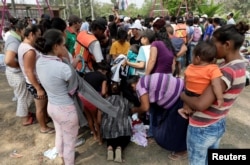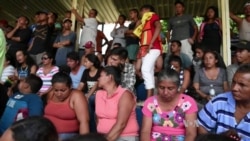White House officials on Wednesday laid out plans to send National Guard troops to the United States’ southern border with Mexico, as part of President Donald Trump’s efforts to confront what he says is a growing problem with illegal immigrants.
The decision to deploy the U.S. military to the border represents a major new aspect of Trump’s wide-ranging immigration crackdown. But major parts of the move are unclear, including how many troops will be sent, when they will deploy, or what exactly they will do.
“It will take time to have the details in place, but we are beginning today and are moving quickly,” said Kirstjen Nielsen, secretary of the Department of Homeland Security. “We are anxious to have this support.”
In the U.S., the active duty military is generally restricted from domestic law enforcement functions, which would include apprehending border crossers. However, U.S. presidents have deployed the National Guard to the border to act in support roles.
Surveillance and support functions
Nielsen said the National Guard troops will help with border surveillance and other “support functions.” She declined to say how large the force would be, but she did say it would include “as many (troops) as is needed to fill the gaps today.”
A senior Trump administration official declined to say whether the National Guard troops will be armed, saying those details are still being worked out. But the official said the force would be effective.
“Suffice it to say, for individuals looking to pay a smuggler to get in the United States right now, that would be a very unwise investment,” the official said.
Trump signed a proclamation authorizing the move Wednesday evening. But states must also approve the decision before deploying their guard members.
Trump repeatedly has threatened to deploy the military to help secure the border, especially as a caravan of Central American migrants makes it way north through Mexico, with some headed for the U.S.
The group of around 1,200 migrants from Central America has been making a 2,000-kilometer (1,200 mile) journey from the Mexico-Guatemala border. Some said they will seek asylum in the U.S., as allowed under U.S. law.
NAFTA threatened
Mexican officials said the caravan has begun to disperse, but some participants said they are going to continue. Trump earlier had warned Mexico that its free trade agreement with its northern neighbor would be jeopardized if it did not stop the caravan before it reached the U.S. border.
Although many of the migrants are fleeing violence, Trump has portrayed the “caravan” as a national security and economic threat that must be stopped.
Trump officials have complained of a rising level of asylum fraud, and said loopholes in U.S. immigration law must be addressed.
Securing the southern border was a centerpiece of Trump’s platform during his 2016 campaign for the presidency, and something he frequently mentions.
WATCH: Border security
“The Mexican border is very unprotected by our laws,” Trump asserted on Tuesday. “We don’t have laws. We have catch and release. You catch and then you immediately release. And people come back years later for a court case, except they virtually never come back.”
Trump has continually emphasized the need for a border wall — which on Tuesday he said must be “700 (1,127 kilometers) to 800 miles (1,287 kilometers) long.” He previously has demanded that Mexico pay for the wall, but he has not emphasized that issue in recent public remarks.
“We need the wall. We’ve started building the wall, as you know,” said Trump, adding that $1.6 billion has now been appropriated by Congress toward “building the wall and fixing the existing wall that’s falling down or was never appropriated in the first place.”
Placating the base
Some see Trump’s move to deploy troops as an attempt to placate his base, especially after many conservatives criticized him for recently signing a government funding bill that did not fund the construction of a border wall.
“The most likely explanation for the proposed deployment is politics, just like the previous deployments,” said Alex Nowrasteh, an immigration analyst at the CATO Institute.
“Since the members of the caravan intend to surrender to Border Patrol or Customs Officers and ask for asylum, the troops serve no purpose. They will not deter asylum seekers,” Nowrasteh said.
But the military can play an important role, said Mark Krikorian, who heads the Center for Immigration Studies, a hardline immigration group.
“Where all the military can help is with all kinds of support functions, like transportation, paperwork, reconnaissance — where they actually do the spotting and identification and tell the border patrol where to go. That sort of thing,” Krikorian said. “There's a lot they can do, but it’s not a silver bullet.”














